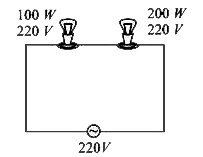Two bulbs 60 W and 100 W designed for voltage 220 V are connected in series across 220 V source. The net power dissipated is
80 W
160 W
60 W
The correct Answer is:C
To find the net power dissipated by the two bulbs (60 W and 100 W) connected in series across a 220 V source, we can follow these steps:
Step 1: Calculate the Resistance of Each Bulb
The resistance of each bulb can be calculated using the formula:
R=V2P
where V is the voltage (220 V) and P is the power rating of the bulb.
- For the 60 W bulb:
R1=220260
- For the 100 W bulb:
R2=2202100
Step 2: Calculate the Equivalent Resistance
Since the bulbs are connected in series, the total or equivalent resistance Req is the sum of the individual resistances:
Req=R1+R2
Step 3: Substitute the Values
Substituting the values of R1 and R2 into the equation for Req:
Req=220260+2202100
Factoring out 2202:
Req=2202(160+1100)
Step 4: Simplify the Expression
To simplify 160+1100:
160+1100=100+606000=1606000
Thus,
Req=2202⋅1606000
Step 5: Calculate the Net Power Dissipated
The net power Pnet dissipated in the circuit can be calculated using the formula:
Pnet=V2Req
Substituting Req:
Pnet=2202Req=22022202⋅1606000=6000160
Step 6: Final Calculation
Calculating the final value:
Pnet=6000160=37.5 W
Thus, the net power dissipated by the two bulbs is 37.5 W.
---
The resistance of each bulb can be calculated using the formula:
R=V2P
where V is the voltage (220 V) and P is the power rating of the bulb.
R1=220260
R2=2202100
Since the bulbs are connected in series, the total or equivalent resistance Req is the sum of the individual resistances:
Req=R1+R2
Substituting the values of R1 and R2 into the equation for Req:
Req=220260+2202100
Factoring out 2202:
Req=2202(160+1100)
To simplify 160+1100:
160+1100=100+606000=1606000
Thus,
Req=2202⋅1606000
The net power Pnet dissipated in the circuit can be calculated using the formula:
Pnet=V2Req
Substituting Req:
Pnet=2202Req=22022202⋅1606000=6000160
Calculating the final value:
Pnet=6000160=37.5 W
Topper's Solved these Questions
- CURRENT ELECTRICITYBOOK - DC PANDEY ENGLISHCHAPTER - CURRENT ELECTRICITYEXERCISE - Match the columns
4 Videos
- COMMUNICATION SYSTEMBOOK - DC PANDEY ENGLISHCHAPTER - COMMUNICATION SYSTEMEXERCISE - Subjective
11 Videos
- ELECTROMAGNETIC INDUCTIONBOOK - DC PANDEY ENGLISHCHAPTER - ELECTROMAGNETIC INDUCTIONEXERCISE - Medical entrances gallery
25 Videos
Similar Questions
Two bulbs of rated power 60W and 100W same specified voltage 220 V are connected in series to a 440 V DC source
View SolutionIf two bulbs of 25Wand100W rated at 220V are connected in series across a 440V supply, will both the bulbs fuse ? If not which one ?
View SolutionTwo bulbs 100W,250V and 200W,250V are connected in parallel across a 500V line. Then-
View SolutionIf two bulbs, both of rated power 100 W at 220 V, are connected in series with a 220 V supply, the total power consumed by the bulbs will be:
View SolutionTen 60 W, 220 V bulbs are connected in series to 220 V supply . Power consumed in the circuit is
View Solution200W and 100W bulbs, both meant for operation at 220V are connected in series to a 200V supply. The power consumed by them will be approximately :

View SolutionThree bulbs of 40W,60Wand100W are connected in series with a 240V source.
View SolutionA 100Ω resistance and a capacitor of 100Ω reactance are connected in series across a 220 V source. When the capacitor is 50% charged, the peak value of the displacement current is
View SolutionA inductor of reactance 1Ω and a resistor of 2Ω are connected in series to the terminals of a 6 V (rms) a.c. source. The power dissipated in the circuit is
View SolutionA inductor of reactance 1Ω and a resistor of 2Ω are connected in series to the terminals of a 6 V (rms) a.c. source. The power dissipated in the circuit is
View Solution
